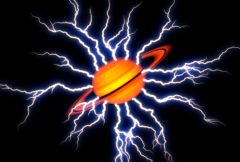S_ZapFrom
Generates multiple lightning bolts outwards from the edges of objects in the FromObj input clip, and renders them over a background input. Use the Show:Edges option to view the source edges while adjusting the Threshold and Blur From Obj parameters.In the Sapphire Render effects submenu.
Inputs:
-
Background: The current layer. The clip to use as background. If none is selected
the main input (the current layer) is also used for the background.
- FromObject: Defaults to None. The edges of objects in this clip are extracted, and the lightning starts at points along these edges.
- Matte: Defaults to None. If provided, the lengths of the bolts in each area are scaled by this input. White areas generate normal bolts, gray areas generate shorter bolts, and black areas cause no bolts to be made.
- FromObject: Defaults to None. The edges of objects in this clip are extracted, and the lightning starts at points along these edges.

|